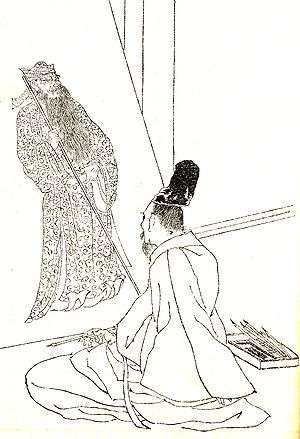Kikuchi Yōsai


Kikuchi Yōsai (菊池 容斎, November 28, 1781 – June 16, 1878), also known as Kikuchi Takeyasu and Kawahara Ryōhei, was a Japanese painter most famous for his monochrome portraits of historical figures.
Life
The son of a samurai named Kawahara of Edo, he was adopted by the Kikuchi family, who were old hereditary retainers of the Tokugawa clan. When eighteen, he became a pupil of Takata Enjō; but, after studying the principles of the Kanō, Shijō, and Maruyama schools, perhaps, under Ozui, a son of Ōkyo, he developed an independent style, having some affinities with that of Tani Bunchō.[1]
His illustrated history of Japanese heroes, the Zenken Kojitsu, is a remarkable specimen of his power as a draughtsman in monochrome ink.[1] In order to produce this work, and his many other portraits of historical figures, he performed extensive historical, and even archaeological, research. Zenken Kojitsu features over 500 major figures in Japanese history, and was originally printed as a series of ten woodblock printed books, in 1878.
Style of painting
Nakane Kōtei (中根 香亭) pointed out that Yōsai modelled the form of "Zenken Kojitsu (前賢故実)" on "Banshōdō Chikusō Gaden (晩笑堂竹荘画伝)" which was drawn by Jō Kan Syū (上官周). Kōtei also said that Yōsai was influenced by Hokusai when young. He thought of the calligraphy as much as the picture when he guided a pupil.
Notes
- 1 2
 One or more of the preceding sentences incorporates text from a publication now in the public domain: Chisholm, Hugh, ed. (1911). "Yōsai". Encyclopædia Britannica. 28 (11th ed.). Cambridge University Press. p. 937.
One or more of the preceding sentences incorporates text from a publication now in the public domain: Chisholm, Hugh, ed. (1911). "Yōsai". Encyclopædia Britannica. 28 (11th ed.). Cambridge University Press. p. 937.
References
- Louis, Frederic (2002). Japan Encyclopedia. Cambridge, Massachusetts: Harvard University Press.
- Kikuchi, Yōsai; Yamashita, Shigetami (1903). 前賢故實: 考證(Zenken kojitsu: kōshō). 東陽堂(Tōyōdō). - facsimile of works.
| Wikimedia Commons has media related to Kikuchi Yosai. |